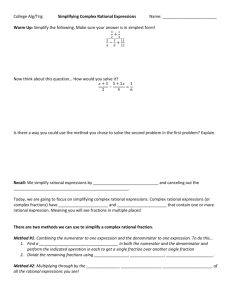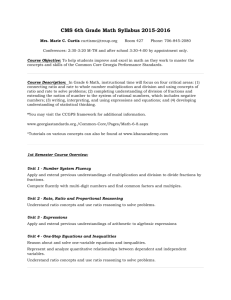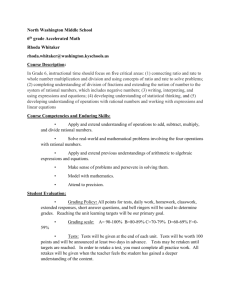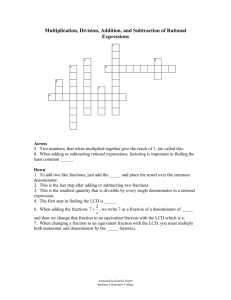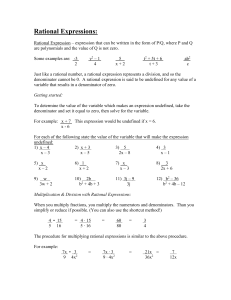Chapter Eleven: Rational Functions
advertisement
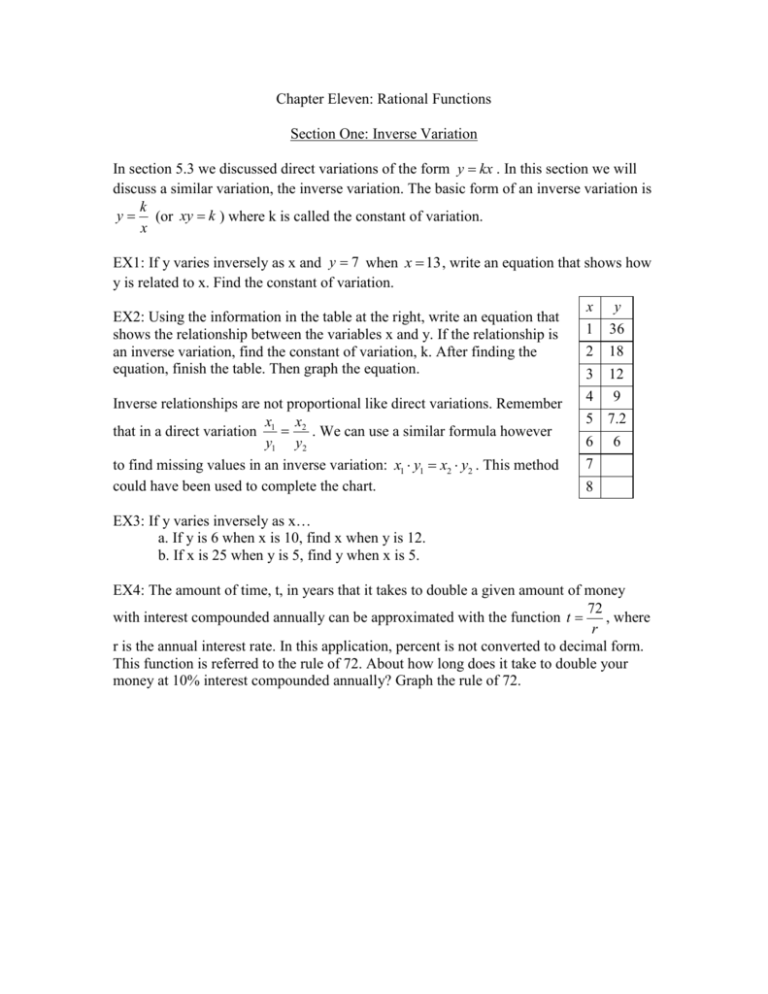
Chapter Eleven: Rational Functions Section One: Inverse Variation In section 5.3 we discussed direct variations of the form y kx . In this section we will discuss a similar variation, the inverse variation. The basic form of an inverse variation is k y (or xy k ) where k is called the constant of variation. x EX1: If y varies inversely as x and y 7 when x 13 , write an equation that shows how y is related to x. Find the constant of variation. EX2: Using the information in the table at the right, write an equation that shows the relationship between the variables x and y. If the relationship is an inverse variation, find the constant of variation, k. After finding the equation, finish the table. Then graph the equation. Inverse relationships are not proportional like direct variations. Remember x x that in a direct variation 1 2 . We can use a similar formula however y1 y2 to find missing values in an inverse variation: x1 y1 x2 y2 . This method could have been used to complete the chart. x y 1 2 36 18 3 12 4 9 5 7.2 6 6 7 8 EX3: If y varies inversely as x… a. If y is 6 when x is 10, find x when y is 12. b. If x is 25 when y is 5, find y when x is 5. EX4: The amount of time, t, in years that it takes to double a given amount of money 72 with interest compounded annually can be approximated with the function t , where r r is the annual interest rate. In this application, percent is not converted to decimal form. This function is referred to the rule of 72. About how long does it take to double your money at 10% interest compounded annually? Graph the rule of 72. Section Two: Rational Expressions and Functions A rational expression is a fraction that contains polynomials as the numerator and A denominator. A rational function is any function of the form y where A and B are B polynomials. When dealing with fractions and division, you may recall that we cannot divide by zero. This means that the denominator of a fraction cannot be zero. When dealing with rational functions, values of the domain that make the bottom of a fraction zero are called excluded values. They are values that are not in the domain. On the graph these excluded values result in either a hole in the graph or a vertical asymptote. A hole is an omitted point on the graph. An asymptote is a line that the graph will get closer and closer to but never cross. EX1: What is the domain of each of the following rational functions? Are these values holes or vertical asymptotes? 3 a. y 2x x2 b. y x x 2 x5 c. y 2 x x 20 EX2: Evaluate each rational function for x 1 and x 2 . Write undefined if appropriate. 5 a. y x2 x 1 b. y 2 x x2 EX3: Graph each function. List any values of x for which the function is undefined. 1 a. y x2 2 4 b. y x 3 Section Three: Simplifying Rational Expressions The following two expressions are equal to each other. 15 x 4 120 x3 260 x 2 120 x 245 3x5 24 x 4 52 x3 24 x 2 49 x and 5 x If you were asked to evaluate the expression for x 5 , which would you rather plug the value into. This shows you how valuable it is to be able to simplify expressions. The main thing to remember when simplifying expressions is this: only factors can be cancelled. You always factor before you try to reduce. EX1: Simplify the expressions. State any excluded values. 4m 20 a. 8m 10 5 x b. 5x 7 x 28 c. 2 x 3 x 28 x2 d. 2 x 5x 6 a 2 b2 e. 2 a 2ab b 2 36 x 2 f. 2 x x 30 EX2: A right cone has a radius of r, a height of h, and a slant height of l. Find the ratio of 1 its volume, r 2 h , to its surface area, r 2 rl . 3 Section Four: Operations with Rational Expressions The applications for rational expressions work the same as the operations for fractions. When multiplying two fractions, we can cross cancel out any common factors. EX1: Multiply. State any excluded values. 2x 2 x 2 a. 5 x 10 2 x 2 7 x2 5 b. x 14 x t 6 4t t 6 c. t 6 9 10t 2 We divide by flipping the second fraction and multiplying. EX2: Divide. State any excluded values. c 5 c 5 a. c 8 c 8 x5 x3 b. x2 x2 x2 x 2 c. x7 We can only add or subtract when the denominators are the same. If they are not we have to find a common denominator. Make sure to factor first step! EX3: Add or subtract. State any excluded values. 2x x 1 a. x3 x4 x 2 b. 2 x 1 x 1 4x 1 2 c. 8x x 2 3a 9 a 3 d. 2 a 6a 9 a 3 Section Five: Solving Rational Functions Remember that when solving equations that contain fractions, we can get rid of the fractions by multiplying the whole equation the LCD. We use this same method to solve rational equations. Solving Rational Equations 1. Factor all the denominators 2. Find a common denominator 3. Multiple every term by the common denominator (this will remove all fractions) 4. Solve the resulting equation 5. Check the original equation to make sure the solution(s) is not an excluded value EX1: Solve the equations. 2x 7 5 2 2 a. x2 x 4 7 18 b. 2 x2 x 2 x 3 1 3 5 c. x x 4 3 y 3 d. 2 2 y 5y 6 y 2 EX2: We can also solve the equations with a graph: x 1 17 x 5 x 5 25 x 2 Section Six: Proof in Algebra


